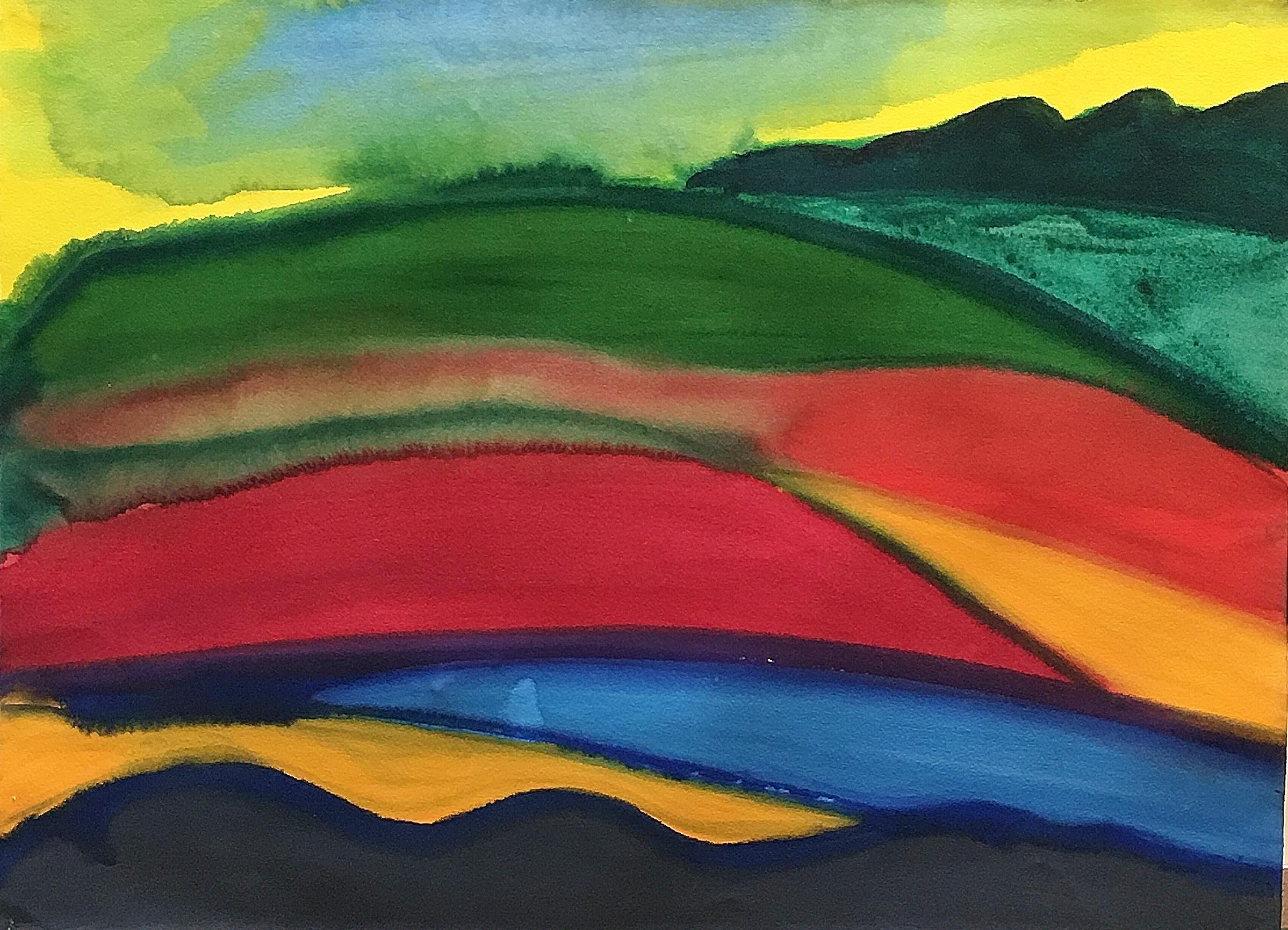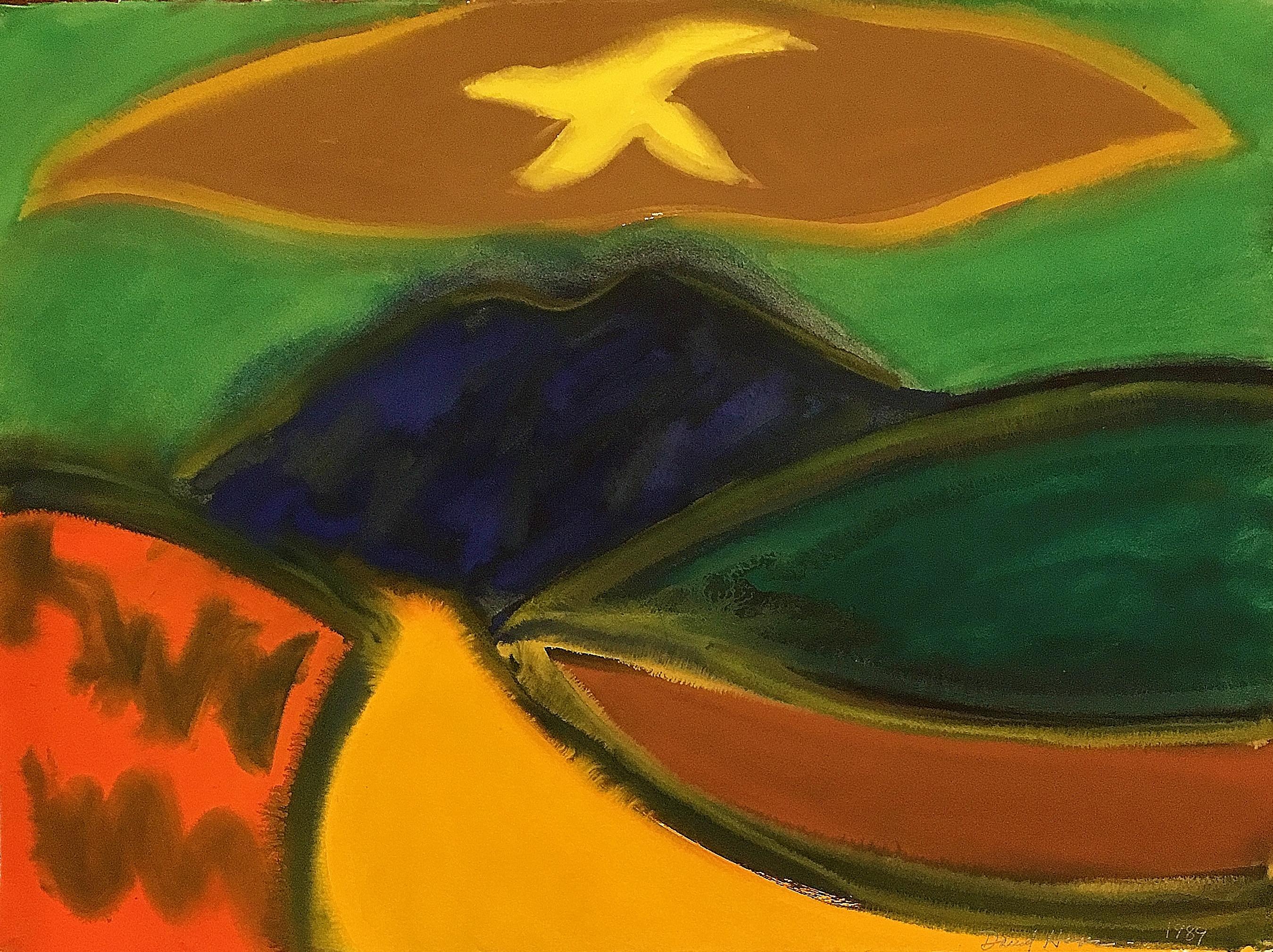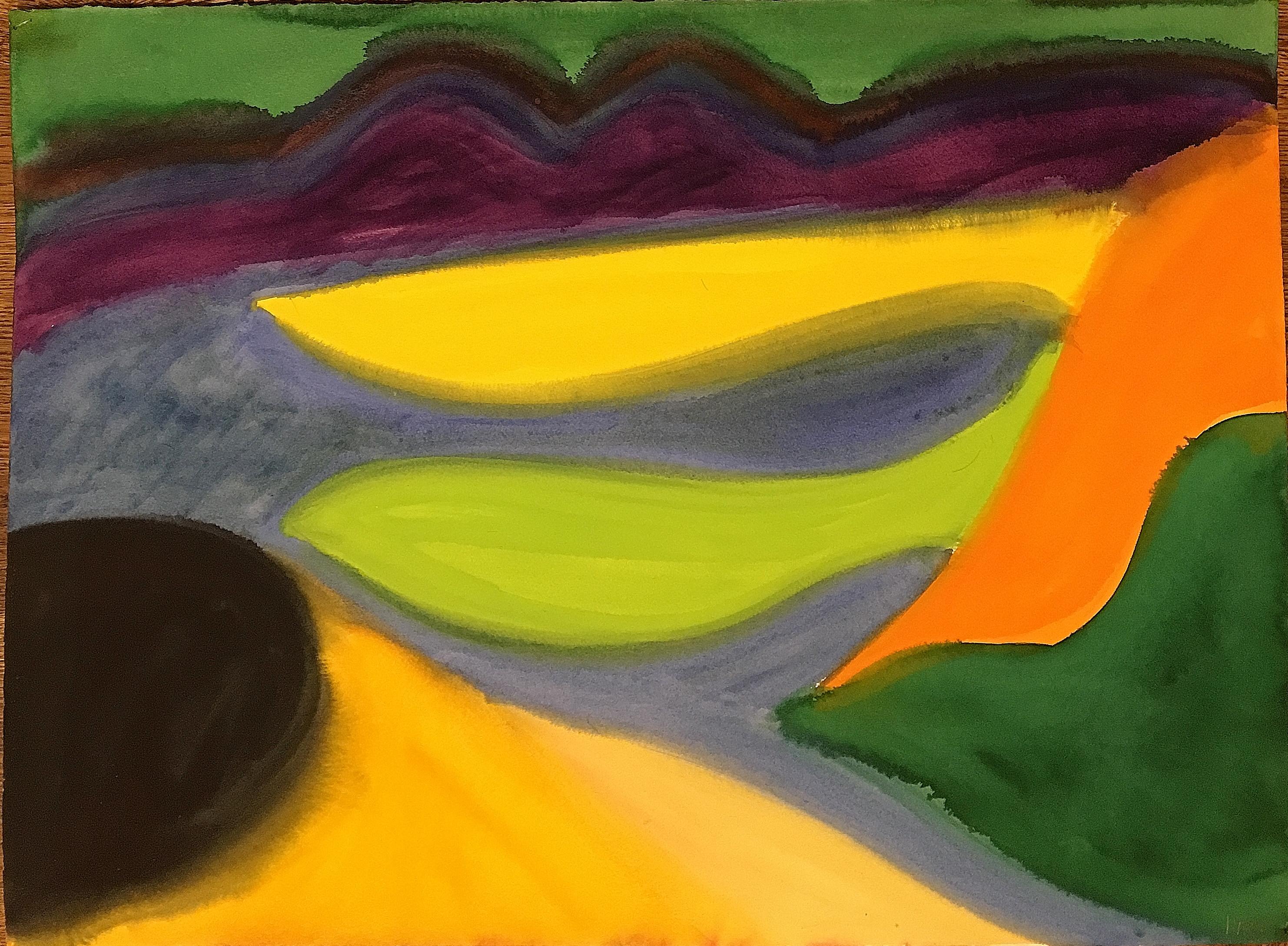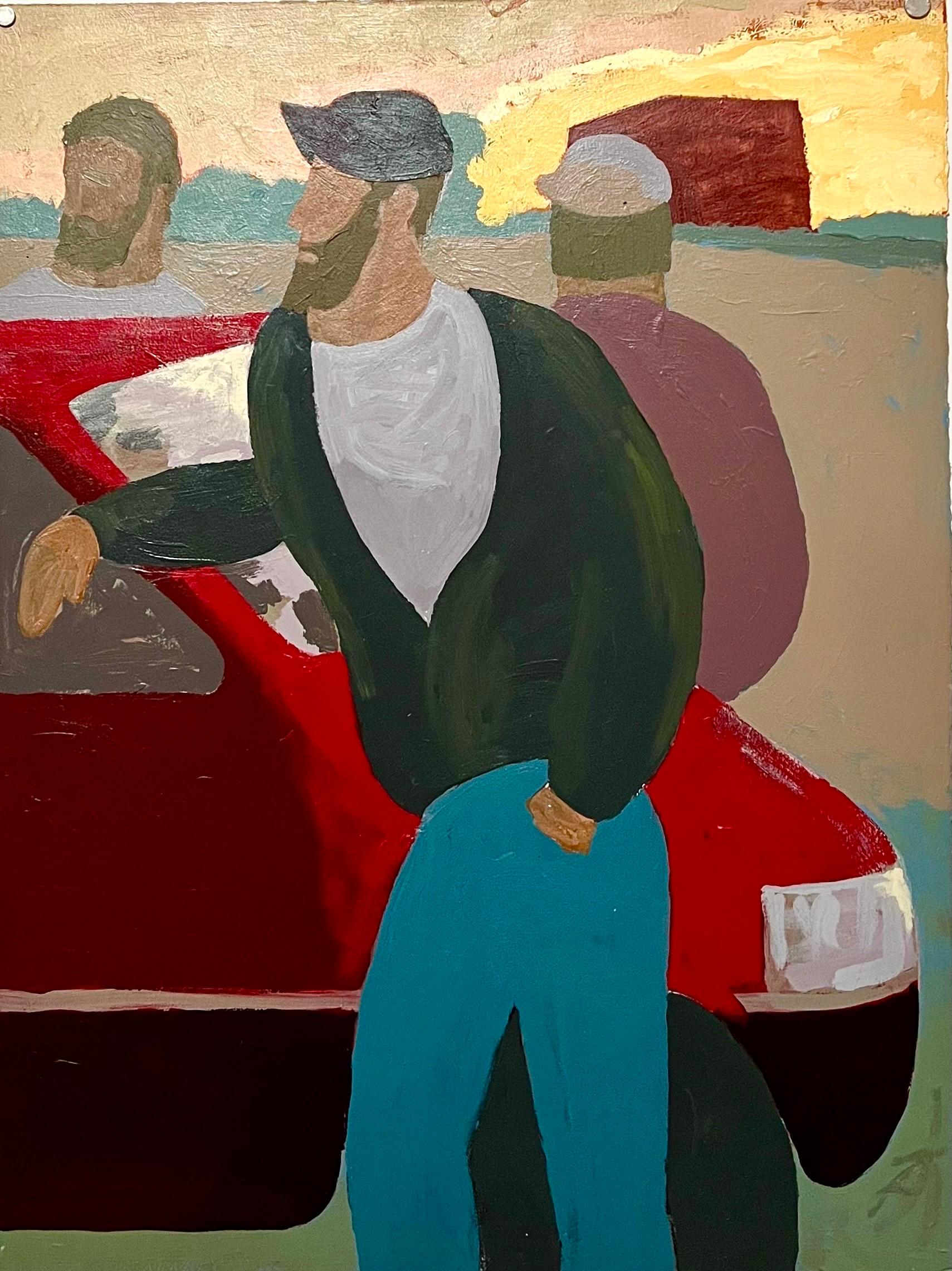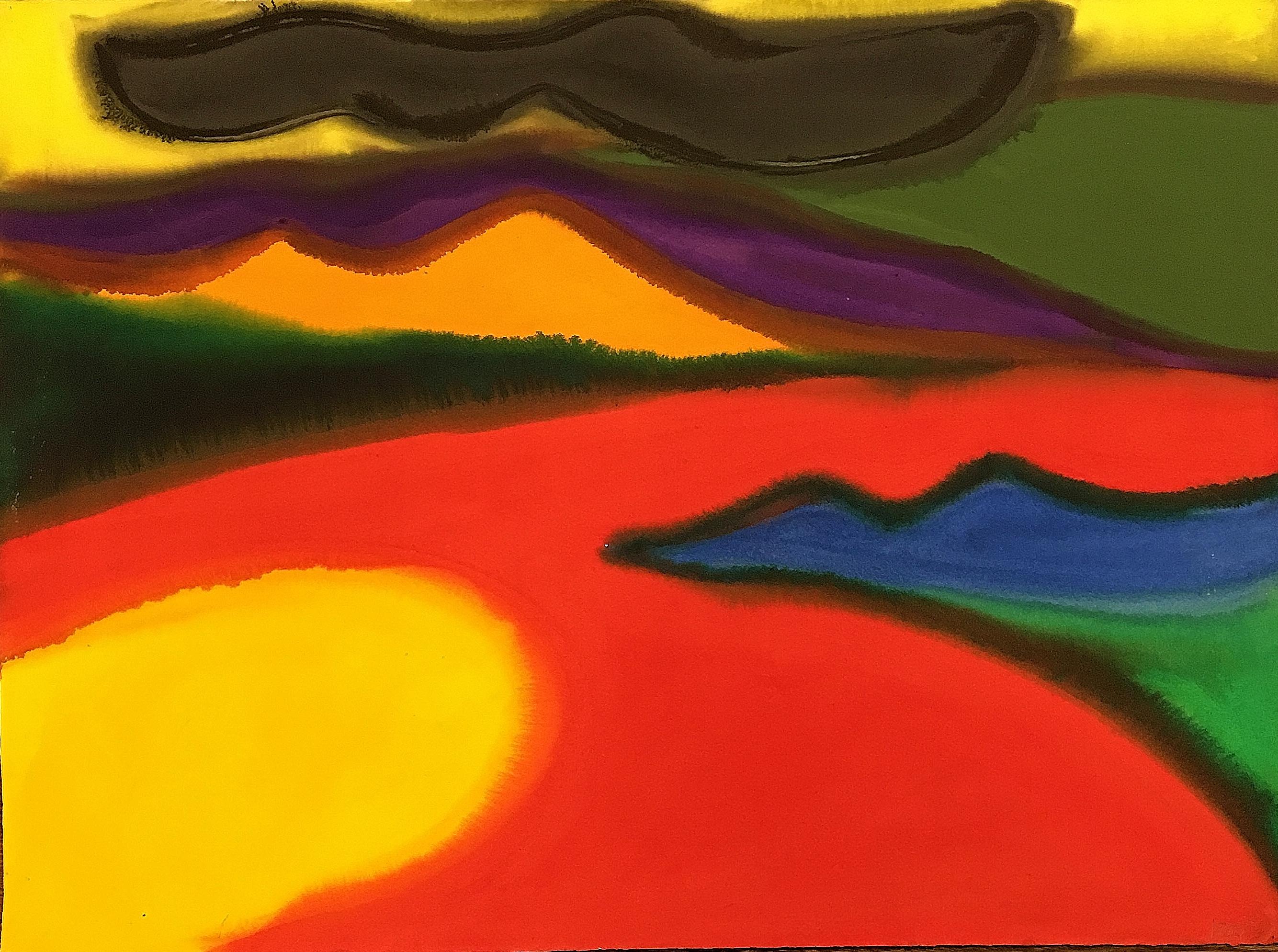Want more images or videos?
Request additional images or videos from the seller
1 of 10
Karl ZerbeArctic Light - Orange Sun1958
1958
About the Item
Arctic Light-Orange Sun
Unsigned
Gouache on Japanese fibrous paper
Series: Tundra Paintings
Exhibited: Karl Zerbe, Gouaches of the Artic
Nordness Gallery, (Madison Avenue, NY) Feb 3 through Feb 23, 1958
Cat. No. 12 (label with work, see photo)
Childs Gallery, Boston,
2017 The Boston Accent: 140 Years of The Museum School
Condition: excellent, one tiny void in the image
Sheet/image size: 24 x 36 1/4 inches
Karl Zerbe was born on September 16, 1903 in Berlin, Germany. The family lived in Paris, France from 1904–1914, where his father was an executive in an electrical supply concern. In 1914 they moved to Frankfurt, Germany where they lived until 1920. Karl Zerbe studied chemistry in 1920 at the Technische Hochschule in Friedberg, Germany.
From 1921 until 1923 he lived in Munich, where he studied painting at the Debschitz School, mainly under Josef Eberz. From 1924 until 1926 Karl Zerbe worked and traveled in Italy on a fellowship from the City of Munich. In 1932 his oil painting titled, ‘’Herbstgarten’’ (autumnal garden), of 1929, was acquired by the National-Galerie, Berlin; in 1937, the painting was destroyed by the Nazis as "Degenerate art."
From 1937 until 1955, Karl Zerbe was the head of the Department of Painting, School of the Museum of Fine Arts, Boston.
In 1939 Karl Zerbe became a U.S. citizen and the same year for the first time he used encaustic. He joined the faculty in the Department of Art and Art History at Florida State University in 1955, where he taught until his death.
He was grouped together with the Boston artists Kahlil Gibran (sculptor), Jack Levine and Hyman Bloom as a key member of the Boston Expressionist school of painting, and through his teaching influenced a generation of painters, including, among others, David Aronson, Bernard Chaet, Reed Kay, Arthur Polonsky, Jack Kramer, Barbara Swan, Andrew Kooistra, and Lois Tarlow.
His works are thought significant because they record "the response of a distinguished artist of basically European sensibility to the physical and cultural scene of the New World".
Solo exhibitions
• 1958, 1959, 1960: Nordness Gallery, New York City
Zerbe's work is in various public collections, including:
• Addison Gallery of American Art, Andover, Massachusetts, United States
• Albright Knox Art Gallery, Buffalo, New York, United States
• Art Institute of Chicago, Chicago, Illinois, United States
• New Britain Museum of American Art, Connecticut, United States
• Auburn University, Auburn, Alabama, United States
• Baltimore Museum of Art, Baltimore, Maryland, United States
• Birmingham Museum of Art, Birmingham, Alabama, United States
• Brooklyn Museum, New York City, New York, United States
• Butler Institute of American Art, Youngstown, Ohio, United States
• Saint Louis Art Museum, St. Louis, Missouri, United States
• Colby College Museum of Art, Waterville, Maine, United States
• Cranbrook Academy of Art, Bloomfield Hills, Michigan, United States
• Currier Museum of Art, Manchester, New Hampshire, United States
• Detroit Institute of Arts, Detroit, Michigan, United States
• Düren Leopold Hoesch Museum
• Fogg Art Museum and the Busch Reisinger Museum at Harvard University, Cambridge, Massachusetts, United States
• Amon Carter Museum, Fort Worth, Texas, United States
• Kestner Museum, Hanover, Germany
• LeMoyne Center for the Visual Arts, Tallahassee, Florida
• Los Angeles County Museum of Art (LACMA), Los Angeles, California, United States
• Massachusetts Institute of Technology, Cambridge, Massachusetts, United States
• Metropolitan Museum of Art, New York City, New York, United States
• Mildred Lane Kemper Art Museum, University of Washington, St. Louis, Missouri, United States
• Mobile Museum of Art, Mobile, Alabama, United States
• Munson-Williams-Proctor Arts Institute, Utica, New York, United States
• Museum of Fine Arts, Boston, Boston, Massachusetts, United States[
• Museum of Modern Art, New York, United States[
• National Gallery of Art, Washington, United States[
• National Institute of Arts and Letters, New York City, New York, United States
• Newark Museum
• Philadelphia Museum of Art
• Rhode Island School of Design Museum, Providence, Rhode Island, United States
• Sarah Lawrence College, Westchester County, New York, United States
• Smith College Museum of Art, Northampton, Massachusetts, United States
• Staatliche Graphische Sammlung, Munich, Germany
• Staedelsches Kunstinstitut, Frankfurt, Germany
• Tel Aviv Museum of Art, Tel Aviv, Israel
• Georgia Museum of Art, Athens, Georgia, United States
• Fred Jones Jr. Museum of Art, Oklahoma City, Oklahoma, United States
• Walker Art Center, Minneapolis, Minnesota, United States[16]
• Whitney Museum of American Art, New York City, New York, United States
• Wichita Art Museum, Wichita, Kansas, United States
Courtesy: Wikipedia
- Creator:Karl Zerbe (1903 - 1972, American, German)
- Creation Year:1958
- Dimensions:Height: 24 in (60.96 cm)Width: 36.25 in (92.08 cm)
- Medium:
- Movement & Style:
- Period:
- Condition:Very good, one small circular void in the fibrous paper from its manufacture.
- Gallery Location:Fairlawn, OH
- Reference Number:
Karl Zerbe
Karl Zerbe was born on September 16, 1903 in Berlin, Germany. The family lived in Paris, France from 1904–1914, where his father was an executive in an electrical supply concern. In 1914 they moved to Frankfurt, Germany where they lived until 1920. Karl Zerbe studied chemistry in 1920 at the Technische Hochschule in Friedberg, Germany. From 1921 until 1923 he lived in Munich, where he studied painting at the Debschitz School, mainly under Josef Eberz. From 1924 until 1926 Karl Zerbe worked and traveled in Italy on a fellowship from the City of Munich. In 1932 his oil painting titled, ‘’Herbstgarten’’ (autumnal garden), of 1929, was acquired by the National-Galerie, Berlin; in 1937, the painting was destroyed by the Nazis as "Degenerate art." From 1937 until 1955, Karl Zerbe was the head of the Department of Painting, School of the Museum of Fine Arts, Boston. In 1939 Karl Zerbe became a U.S. citizen and the same year for the first time he used encaustic. He joined the faculty in the Department of Art and Art History at Florida State University in 1955, where he taught until his death. He was grouped together with the Boston artists Kahlil Gibran (sculptor), Jack Levine and Hyman Bloom as a key member of the Boston Expressionist school of painting,[5] and through his teaching influenced a generation of painters, including, among others, David Aronson, Bernard Chaet, Reed Kay, Arthur Polonsky, Jack Kramer, Barbara Swan, Andrew Kooistra, and Lois Tarlow. His works are thought significant because they record "the response of a distinguished artist of basically European sensibility to the physical and cultural scene of the New World"
About the Seller
5.0
Recognized Seller
These prestigious sellers are industry leaders and represent the highest echelon for item quality and design.
Platinum Seller
These expertly vetted sellers are 1stDibs' most experienced sellers and are rated highest by our customers.
Established in 1978
1stDibs seller since 2013
713 sales on 1stDibs
Typical response time: 1 hour
Associations
International Fine Print Dealers Association
- ShippingRetrieving quote...Ships From: Fairlawn, OH
- Return PolicyA return for this item may be initiated within 10 days of delivery.
More From This SellerView All
- Arctic Light - Orange SunBy Karl ZerbeLocated in Fairlawn, OHArctic Light-Orange Sun Unsigned Gouache on Japanese fibrous paper Series: Tundra Paintings Exhibited: Karl Zerbe, Gouaches of the Artic Nordness Gallery, (Madison...Category
1950s American Modern Abstract Paintings
MaterialsGouache
- Landscape with TreesBy Leon KellyLocated in Fairlawn, OHLandscape with Trees Watercolor on paper, 1929 Signed in pencil lower right corner Obviously influenced by the Cezanne works in the collection of his patron Alfred C. Barnes of Phila...Category
1920s American Modern Landscape Paintings
MaterialsWatercolor
- Park Scene (Chelsea, Manhattan)By Virginia DehnLocated in Fairlawn, OHPark Scene (Chelsea, Manhattan) Oil on artist's board, c. 1947-49 Signed lower right (see photo) Provenance: Estate of the artist Dehn Heirs Condition: Good, needs a light cleaning Original wormy chestnut frame Painting size: 9 1/4 x 12 inches Frame size: 14 1/4 x 17 inches One of the earliest know Virginia Dehn paintings after her marriage to Adolf in 1947. The lived in Chelsea at 433 West 21st St. Inscription by artist verso: Virginia Dehn 443 W. 21 St. New York City V.70 Virginia Dehn From Wikipedia, the free encyclopedia Virginia Dehn Virginia Dehn in her studio in Santa Fe Virginia Dehn (née Engleman) (October 26, 1922 – July 28, 2005) was an American painter and printmaker. Her work was known for its interpretation of natural themes in almost abstract forms. She exhibited in shows and galleries throughout the U.S. Her paintings are included in many public collections. Life Dehn was born in Nevada, Missouri on October 26, 1922.] Raised in Hamden, Connecticut, she studied at Stephens College in Columbia, Missouri before moving to New York City. She met the artist Adolf Dehn while working at the Art Students League. They married in November 1947. The two artists worked side by side for many years, part of a group of artists who influenced the history of 20th century American art. Their Chelsea brownstone was a place where artists, writers, and intellectuals often gathered. Early career Virginia Dehn studied art at Stephens College in Missouri before continuing her art education at the Traphagen School of Design, and, later, the Art Students League, both located in New York City. In the mid-1940s while working at the Associated American Artists gallery, she met lithographer and watercolorist Adolf Dehn. Adolf was older than Virginia, and he already enjoyed a successful career as an artist. The two were married in 1947 in a private ceremony at Virginia's parents house in Wallingford, Connecticut. Virginia and Adolf Dehn The Dehns lived in a Chelsea brownstone on West 21st Street where they worked side by side. They often hosted gatherings of other influential artists and intellectuals of the 20th century. Among their closest friends were sculptor Federico Castellón and his wife Hilda; writer Sidney Alexander and his wife Frances; artists Sally and Milton Avery; Ferol and Bill Smith, also an artist; and Lily and Georges Schreiber, an artist and writer. Bob Steed and his wife Gittel, an anthropologist, were also good friends of the Dehns. According to friend Gretchen Marple Pracht, "Virginia was a glamorous and sophisticated hostess who welcomed visitors to their home and always invited a diverse crowd of guests..." Despite their active social life, the two were disciplined artists, working at their easels nearly daily and taking Saturdays to visit galleries and view new work. The Dehns made annual trips to France to work on lithographs at the Atelier Desjobert in Paris. Virginia used a bamboo pen to draw directly on the stone for her lithographs, which often depicted trees or still lifes. The Dehns' other travels included visits to Key West, Colorado, Mexico, and countries such as Greece, Haiti, Afghanistan, and India. Dehn's style of art differend greatly from that of her husband, though the two sometimes exhibited together. A friend of the couple remarked, "Adolf paints landscapes; Virginia paints inscapes." Virginia Dehn generally painted an interior vision based on her feelings for a subject, rather than a literal rendition of it.] Many of her paintings consist of several layers, with earlier layers showing through. She found inspiration in the Abstract Expressionism movement that dominated the New York and Paris art scenes in the 1950s. Some of her favorite artists included Adolf Gottileb, Rothko, William Baziotes, Pomodoro, and Antonio Tapies. Dehn most often worked with bold, vibrant colors in large formats. Her subjects were not literal, but intuitive. She learned new techniques of lithography from her husband Adolf, and did her own prints. Texture was very important to her in her work. Her art was influenced by a variety of sources. In the late 1960s she came across a book that included photographs of organic patterns of life as revealed under a microscope. These images inspired her to change the direction of some of her paintings. Other influences on Dehn's art came from ancient and traditional arts of various cultures throughout the world, including Persian miniatures, illuminated manuscripts, Dutch still life painting, Asian art, ancient Egyptian artifacts...Category
1940s American Modern Landscape Paintings
MaterialsOil
- Ossabaw (Georgia) InletBy Virginia DehnLocated in Fairlawn, OHOssabaw Inlet Acrylic on paper Signed in ink lower right Ossabaw Sound Inlet in Ossbaw Island Georgia, locate along the Atlantic Ocean near Hinesville GA "During her artistic career, Dehn received fellowships from Yaddo, MacDowell Colony and Ossabaw Island Project. " Wikipedia Condition: Excellent Image/sheet size: 12 1/8 x 17 5/8 inches Provenance: estate of the artist Dehn Heirs Virginia Dehn Virginia Dehn in her studio in Santa Fe Virginia Dehn (née Engleman) (October 26, 1922 – July 28, 2005) was an American painter and printmaker. Her work was known for its interpretation of natural themes in almost abstract forms. She exhibited in shows and galleries throughout the U.S. Her paintings are included in many public collections. Life Dehn was born in Nevada, Missouri on October 26, 1922.] Raised in Hamden, Connecticut, she studied at Stephens College in Columbia, Missouri before moving to New York City. She met the artist Adolf Dehn while working at the Art Students League. They married in November 1947. The two artists worked side by side for many years, part of a group of artists who influenced the history of 20th century American art. Their Chelsea brownstone was a place where artists, writers, and intellectuals often gathered. Early career Virginia Dehn studied art at Stephens College in Missouri before continuing her art education at the Traphagen School of Design, and, later, the Art Students League, both located in New York City. In the mid-1940s while working at the Associated American Artists gallery, she met lithographer and watercolorist Adolf Dehn. Adolf was older than Virginia, and he already enjoyed a successful career as an artist. The two were married in 1947 in a private ceremony at Virginia's parents house in Wallingford, Connecticut. Virginia and Adolf Dehn The Dehns lived in a Chelsea brownstone on West 21st Street where they worked side by side. They often hosted gatherings of other influential artists and intellectuals of the 20th century. Among their closest friends were sculptor Federico Castellón and his wife Hilda; writer Sidney Alexander and his wife Frances; artists Sally and Milton Avery; Ferol and Bill Smith, also an artist; and Lily and Georges Schreiber, an artist and writer. Bob Steed and his wife Gittel, an anthropologist, were also good friends of the Dehns. According to friend Gretchen Marple Pracht, "Virginia was a glamorous and sophisticated hostess who welcomed visitors to their home and always invited a diverse crowd of guests..." Despite their active social life, the two were disciplined artists, working at their easels nearly daily and taking Saturdays to visit galleries and view new work. The Dehns made annual trips to France to work on lithographs at the Atelier Desjobert in Paris. Virginia used a bamboo pen...Category
1990s American Modern Landscape Paintings
MaterialsAcrylic
- Canyon CountryBy William C. GrauerLocated in Fairlawn, OHAcrylic on board Signed lower right corner Condition: Painting is excellent Frame has surface wear Provenance: Estate of the artist William C. Grauer (1895-1985) William C. Grauer (1895-1985) was born in Philadelphia to German immigrant parents. After attending the Philadelphia Museum School of Industrial Art, Grauer received a four year scholarship from the City of Philadelphia to pursue post graduate work. It was during this time that Grauer began working as a designer at the Decorative Stained Glass Co. in Philadelphia. Following his World War I service in France, Grauer moved to Akron, Ohio where he opened a studio in 1919 with his future brother-in-law, the architect George Evans...Category
1970s American Modern Landscape Paintings
MaterialsABS, Acrylic
- Gaspe HomesBy William C. GrauerLocated in Fairlawn, OHTitle Unknown (Gaspe Bay Houses) Acrylic on board, 46 1/4 x 34 inches Signed lower right Condition: Good Minor surface wear to the frame Provenance: Estate of the artist by decent to his daughter Gretchen William C. Grauer (1895-1985) William C. Grauer (1895-1985) was born in Philadelphia to German immigrant parents. After attending the Philadelphia Museum School of Industrial Art, Grauer received a four year scholarship from the City of Philadelphia to pursue post graduate work. It was during this time that Grauer began working as a designer at the Decorative Stained Glass Co. in Philadelphia. Following his World War I service in France, Grauer moved to Akron, Ohio where he opened a studio in 1919 with his future brother-in-law, the architect George Evans...Category
1970s American Modern Landscape Paintings
MaterialsAcrylic
You May Also Like
- Hillside PatternsBy David HayesLocated in Lawrence, NYGouache on paper signed en verso Throughout his sixty-year artistic career, David Hayes created sculptural forms abstracted from organic forms encountered in daily life. He first studied with American sculptor David Smith, who was among the first to work with welded steel. Hayes' sculptures have affinities to Alexander Calder's playful stabiles (Hayes met Calder in Paris) and to the shapes and colors of Matisse's late paper cutouts. Hayes works are firmly rooted in modern artists' interests in industrial materials and in commercial fabrication processes. He has had more than 400 exhibitions of his work. His work is in more than 70 museum collections, including MOMA and the Guggenheim. Throughout his career, Hayes painted models for his sculptures and sculptural-like landscapes of the geography surrounding his home in Northwestern Connecticut. In these landscapes, the gently rolling hills become modernist forms and shapes, recognizable as landscapes but also as explorations of shape and color. These are intriguing works of art in and of themselves. Lawrence Fine Art...Category
1980s American Modern Landscape Paintings
MaterialsGouache
- Starred CloudBy David HayesLocated in Lawrence, NYGouache on paper signed en verso Throughout his sixty-year artistic career, David Hayes created sculptural forms abstracted from organic forms encountered in daily life. He first studied with American sculptor David Smith, who was among the first to work with welded steel. Hayes' sculptures have affinities to Alexander Calder's playful stabiles (Hayes met Calder in Paris) and to the shapes and colors of Matisse's late paper cutouts. Hayes works are firmly rooted in modern artists' interests in industrial materials and in commercial fabrication processes. He has had more than 400 exhibitions of his work. His work is in more than 70 museum collections, including MOMA and the Guggenheim. Throughout his career, Hayes painted models for his sculptures and sculptural-like landscapes of the geography surrounding his home in Northwestern Connecticut. In these landscapes, the gently rolling hills become modernist forms and shapes, recognizable as landscapes but also as explorations of shape and color. These are intriguing works of art in and of themselves. Lawrence Fine Art...Category
1980s American Modern Landscape Paintings
MaterialsGouache
- Spring PatternBy David HayesLocated in Lawrence, NYGouache on paper signed en verso Throughout his sixty-year artistic career, David Hayes created sculptural forms abstracted from organic forms encountered in daily life. He first studied with American sculptor David Smith, who was among the first to work with welded steel. Hayes' sculptures have affinities to Alexander Calder's playful stabiles (Hayes met Calder in Paris) and to the shapes and colors of Matisse's late paper cutouts. Hayes works are firmly rooted in modern artists' interests in industrial materials and in commercial fabrication processes. He has had more than 400 exhibitions of his work. His work is in more than 70 museum collections, including MOMA and the Guggenheim. Throughout his career, Hayes painted models for his sculptures and sculptural-like landscapes of the geography surrounding his home in Northwestern Connecticut. In these landscapes, the gently rolling hills become modernist forms and shapes, recognizable as landscapes but also as explorations of shape and color. These are intriguing works of art in and of themselves. Lawrence Fine Art...Category
1990s American Modern Landscape Paintings
MaterialsGouache
- UntitledBy David HayesLocated in Lawrence, NYGouache on paper signed en verso Throughout his sixty-year artistic career, David Hayes created sculptural forms abstracted from organic forms encountered in daily life. He first studied with American sculptor David Smith, who was among the first to work with welded steel. Hayes' sculptures have affinities to Alexander Calder's playful stabiles (Hayes met Calder in Paris) and to the shapes and colors of Matisse's late paper cutouts. Hayes works are firmly rooted in modern artists' interests in industrial materials and in commercial fabrication processes. He has had more than 400 exhibitions of his work. His work is in more than 70 museum collections, including MOMA and the Guggenheim. Throughout his career, Hayes painted models for his sculptures and sculptural-like landscapes of the geography surrounding his home in Northwestern Connecticut. In these landscapes, the gently rolling hills become modernist forms and shapes, recognizable as landscapes but also as explorations of shape and color. These are intriguing works of art in and of themselves. Lawrence Fine Art...Category
1980s American Modern Landscape Paintings
MaterialsGouache
- Large Hudson River Figurative Modernist Landscape Oil Painting Edward AvedisianBy Edward AvedisianLocated in Surfside, FLEdward Avedisian ( 1936-2007 ) Gouache or oil on paper, 3 guys around a car, hand signed in paint lower left, Measures 30"x 22.5" Edward Avedisian (June 15, 1936, Lowell, Massachusetts – August 17, 2007, Philmont, New York) was an American abstract painter who came into prominence during the 1960s. His work was initially associated with Color field painting and in the late 1960s with Lyrical Abstraction and Abstract Expressionism. He studied art at the School of the Museum of Fine Arts, Boston. By the late 1950s he moved to New York City. Between 1958 and 1963 Avedisian had six solo shows in New York. In 1958 he initially showed at the Hansa Gallery, then he had three shows at the Tibor de Nagy Gallery and in 1962 and 1963 at the Robert Elkon Gallery. He continued to show at the Robert Elkon Gallery almost every year until 1975. During the 1960s his work was broadly visible in the contemporary art world. He joined the dynamic art scene in Greenwich Village, frequenting the Cedar Tavern on Tenth Street, associating with the critic Clement Greenberg, and joining a new generation of abstract artists, such as Darby Bannard, Kenneth Noland, Jules Olitski, and Larry Poons. Avedisian was among the leading figures to emerge in the New York art world during the 1960s. An artist who mixed the hot colors of Pop Art with the cool, more analytical qualities of Color Field painting, he was instrumental in the exploration of new abstract methods to examine the primacy of optical experience. One of his paintings was appeared on the cover of Artforum, in 1969, his work was included in the 1965 Op Art The Responsive Eye exhibition at the Museum of Modern Art and in four annuals at the Whitney Museum of American Art. His paintings were widely sought after by collectors and acquired by major museums in New York and elsewhere. He has been exhibited in prominent galleries, such as the Anita Shapolsky Gallery and the Berry Campbell Gallery in New York City. Edward Avedisian was known for his brightly colored, boldly composed canvases that combined Minimalism's rigor, Pop art exuberance and the saturated tones of Color Field painting. Roberta Smith of the NYT writes of Avedesian: "Edward Avedisian helped establish the hotly colored, but emotionally cool, abstract painting that succeeded Abstract Expressionism in the early 1960s. This young luminary harnessed elements of minimalism, pop, and color field painting to create prominent works of epic proportions that energized the New York art scene of the time." In 1996 Avedisian showed his paintings from the 1960s at the Mitchell Algus Gallery, then in SoHo. His last show, dominated by recent landscapes, was in 2003 at the Algus gallery, now in Chelsea. Selected Exhibitions: Op Art: The Responsive Eye, at the Museum of Modern Art, Whitney Museum’s Young America 1965 Expo 67, held in Montreal, Canada. Six Painters (along with Darby Bannard, Dan Christensen, Ron Davis...Category
20th Century American Modern Landscape Paintings
MaterialsOil, Gouache, Archival Paper
- Construction SiteBy David HayesLocated in Lawrence, NYGouache on paper signed en verso Throughout his sixty-year artistic career, David Hayes created sculptural forms abstracted from organic forms encountered in daily life. He first studied with American sculptor David Smith, who was among the first to work with welded steel. Hayes' sculptures have affinities to Alexander Calder's playful stabiles (Hayes met Calder in Paris) and to the shapes and colors of Matisse's late paper cutouts. Hayes works are firmly rooted in modern artists' interests in industrial materials and in commercial fabrication processes. He has had more than 400 exhibitions of his work. His work is in more than 70 museum collections, including MOMA and the Guggenheim. Throughout his career, Hayes painted models for his sculptures and sculptural-like landscapes of the geography surrounding his home in Northwestern Connecticut. In these landscapes, the gently rolling hills become modernist forms and shapes, recognizable as landscapes but also as explorations of shape and color. These are intriguing works of art in and of themselves. Lawrence Fine Art...Category
1980s American Modern Landscape Paintings
MaterialsGouache
